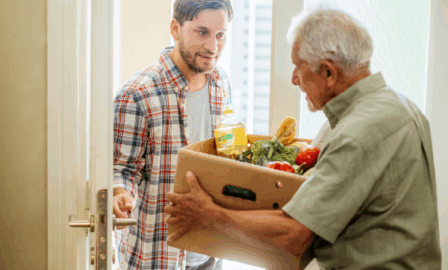From Pandemic to Inflation: Strategies for Grocery Retailers in 2023
We outline grocery retailer strategies to support your digital modernization journey and to help your organization stay ahead of competition amidst market changes.
During the COVID-19 pandemic, eCommerce grew drastically in several industries, with online grocery shopping becoming a popular option. Many customers sought to avoid in-person shopping altogether, so grocers began to offer curbside pick-up and delivery for customer purchases. As the impacts of the pandemic are now waning, digital grocery shopping sales are seeing a decline, and eCommerce grocery shopping recorded a 1.8% decline in the first 6 months of 2023 as compared to 2022. However, larger corporations, such as Walmart and Target, haven’t seen the same decline in their eCommerce grocery sales, likely due to their affordable price points and strong delivery and pick-up channels.
Some of these changes are likely driven by the transition from the pandemic to a state of inflation. Customers are opting less for convenience and focusing instead on deal hunting and bargain shopping. There’s also a smaller population working entirely from home, as society is shifting more toward a hybrid workplace.
Below are some key trends and points to consider as grocers reevaluate their retail strategies, capabilities, and supporting technologies to better accommodate changing customer lifestyles and preferences.
Changes in Customer Preferences
Customers have rapidly adapted to changing societal and economic norms. In a 84.51° report on grocery customers, 14% of shoppers plan to do less online grocery shopping in 2023 compared to the previous year. Some customers report they prefer to see products and shop in person, allowing them to better find and compare products and take advantage of sales and promotions. In-store shopping also provides a more immediate purchase, as no processing or delivery time is required. These preferences could be contributing to the decline in eCommerce sales as shoppers rely less on the digital storefront as a primary channel.
However, many shoppers still choose to purchase groceries in a hybrid, omnichannel manner – 22% of shoppers plan online orders with an accompanying in-store shopping trip. In-store shopping is fast and allows easy product comparison, but delivery and curbside pick-up still offer the ease and convenience that many customers enjoyed during the pandemic. There are also shopper differences based on lifestyles – customers with kids are much more likely to shop online. These differing preferences have created a diverse market that offers retailers many opportunities to cater to their shoppers in unique ways.
As the economy continues to experience high rates of inflation, shoppers are increasingly making choices between affordability and convenience, and many will go out of their way to explore multiple retailers to ensure they’re receiving the best deal. Customers are also seeking more cost-effective options with private label brands and bulk shopping, both at membership-based retailers and open retailers, in order to save money. This also contributes to the return to in-store shopping. Many customers simply find it easier to explore deals and compare prices in the physical store.
Response Strategies Coming into Play
Evaluating product assortment and pricing strategy: Grocers are revamping their private label offerings to compete with branded GPGs, provide economical options to their shoppers, and drive brand loyalty. As shoppers are also looking to buy in bulk to stretch their dollar, retailers can also tailor their promotion strategy to take advantage of the 50% of shoppers who stock up when items are on sale. It’s imperative for grocers to have the right technologies and processes in place to capture and analyze the promotions’ effectiveness to continuously iterate and improve with the ever-changing customer preferences and macro-trends.
Uniting the digital and in-store shopping experience: As shoppers still report gaps between the online and brick-and-mortar environments, grocers can take a two-headed approach to provide seamless experiences across channels. From an online perspective, grocers are focusing on recreating some of the in-store experiences, such as making it easier for shoppers to more easily compare products, find sales, and clip digital coupons, as well as offering online chat options to connect shoppers with the retailer. Grocers are also becoming increasingly conscious of their visual brand online, using specific product image organization to highlight similar options and product differences. From an in-store perspective, retailers can leverage their mobile app to enhance the shopping experience. For example, retailers can offer QR codes within the store, allowing customers to scan and see product details or reviews, compare products, or see more detailed sustainability data. Incorporating the mobile app in the shopping experiences also provides retailers more touchpoints with the shopper throughout their trip, enabling opportunities to remind them of certain promotions, suggest products, or even navigate the store to find items. Some retailers have offered novel digital and in-person cooking experiences and recipes to highlight potential product uses.
Leveraging loyalty programs, data, and personalization to drive improved customer experience: Loyalty programs are also increasingly important for retaining a customer base as prices rise. Regional grocers in particular must establish streamlined and rewarding customer loyalty programs to stay on par with larger corporations. These programs also open the door for personalized deals, as coupons can be customized based on customer purchasing preferences and shopping history. Whether through online, in-store, or hybrid channels, retailers should look to understand their shopper segments and provide seamless, tailored experiences to improve their shopping experience and drive repeat business.
Digital Modernization Journey: Grocery Retailer Strategies
Efficiently and intentionally leveraging online and in-store technology is a key component for retailers looking to drive omnichannel sales and customer engagement. However, there’s a large spectrum for where these organizations may fall on their own digital journey – some may have limited loyalty programs, disjointed online and in-store shopping experiences, and no mobile app, while other more advanced organizations are much further along in these areas and are focused on incorporating novel AI and AR experiences into their capabilities.
No matter where a grocery retailer stands in their digital maturity, Clarkston can help with accelerating this pathway to digital modernization. We assist retailers in defining a tailored strategy and roadmap to achieve these capabilities and implementing new technologies to enhance their shopping experiences and drive channel growth.
Contact our retail experts today to discuss how your organization can take the next step in its digital modernization journey and prepare successful grocery retailer strategies.
Subscribe to Clarkston's Insights
Contributions from Sam Weitzel



